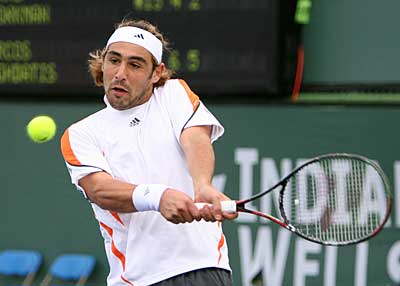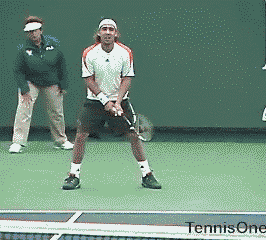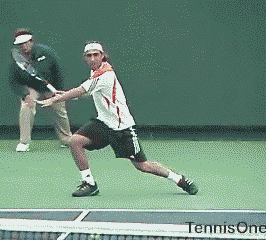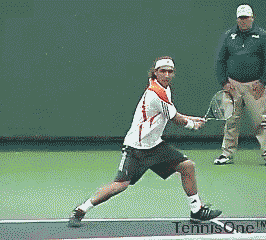|
TennisOne Lessons Marcos Baghdatis by Jim McLennan Marcos Baghdatis has emerged on the tour. Following an electrifying run to the finals of the 2006 Australian Open, he is in demand on the grounds of the Pacific Life Open. Instantly recognizable, and with an engaging smile, he is hounded for autographs, his practice sessions have become “mini events.”
Children and adults are drawn to the magnetic charisma of this “new star.” But aside from personality, there is something equally engaging about his style of play. He favors shot selection over power hitting, he varies his court positioning from behind to well inside the baseline, and his aces (though his first serves are generally clocked in the mid 120’s) are secured with placement rather than power. Watching him practice this week, and in his first round victory over Jonas Bjorkman, I am taken with his creativity, his feel for the game, his ability to truly play rather than simply hit. As I watched the pros on the practice courts this week, I am continually struck by the following, and this holds for the men as well as the women. Warm-ups and general hitting enable the players to get their feel, to sense the speed of the court, gauge the wind, and loosen up. Further, in most of these sessions the players are hitting rather than running, and they are working mostly on their mechanics rather than their patterns and point construction. But it seems to me, that this practice style may actually discourage creativity, inhibit varying court positioning, and inadvertently encourage a similar mindless hitting style in actual matches. They all hit the ball so hard, and with such rhythm, that somehow I see that style carrying over into the matches. For all the professionals who know they should improve their coming in game, and this includes Hewitt, Roddick, and many many more, it appears to me that no one, repeat no one, ever actually shows an eagerness if even willingness to step forward and take the occasional ball on the rise. Sampras knew how to step forward, McEnroe knew how to step forward, certainly Federer knows how to step forward, and Marcos definitely knows how to step forward.
His game is more about using pace rather than creating it; about anticipation and sensing the opponent’s options; about making nearly all of his returns. The intent being to simply make the opponent play, at the same time reducing the opponent’s options and often making them hit unfamiliar shots and play in difficult situations. So what are the take-aways that you and I can first see, and then try to feel as we play a recreational version of the professional game? Make all your service returns – Marcos is the model of simplicity. His racquet work is much like Andre Agassi (but without the ferocity) – quick but abbreviated backswings, and always moving forward into the ball. Too often we (the normal people) focus on taking the racquet back, rather than simply turning to the side. Because his racquet work is brief (as opposed to my friend Andy R.) he is able to stand on or even inside the baseline, and I believe similar positioning will help you and I. Further, taking a page from Tom Stow, Marcos “borrows” the pace from the server – he is not creating power but simply using the incoming momentum to his own effect. McEnroe knew this, as does Federer. Hit and move When we think of footwork, generally it is about moving to the ball and getting into a good position for the swing. Overlooked, is the equal, if not more important, task of moving quickly back into position after the shot. In this regard, Baghdatis is catlike quick in his recovery movements an instant after contact. And this couples nicely with simple stroking, because as he or you and I stay a little closer to the baseline, this will often reduce the distance for subsequent recovery footwork. Relax Baghdatis is a model of relaxation and posture. While many of the professionals may be lifting too many weights and pursuing muscularity over functionality, Marcos takes a page from the Alexander training method.
Watching his initial moves when returning serve, there is no, repeat no, tightening in his shoulders or arms. Some of the stronger guys on the tour appear to muscle the ball, but if you look closely, his return appears almost playful, a simple turn step and hit. As an aside, one of our writers, Gary Adelman (see library) encouraged me to take some Alexander technique lessons, which I did with a wonderful practitioner in the Bay Area named Ed Avak. The training is all about how the head sits on the shoulders, a feeling of lengthening the spine and opening the shoulders. The training has changed my awareness as a teacher, for now in many instances I am noticing a hunched tightness in many players at our club (and for that matter on tour as well), and when they are focusing on their grip or their swing, I am drawn to a more central issue that truly precedes their technique, and this is how they hold their body in the ready position and how they hold their body as they stroke the ball Enjoy the game Marcos plays with a quiet yet manageable intensity. There is a classic relationship between performance and arousal. Too low an arousal state and performance is poor. But equally, too high an arousal state and the resulting tightness and expectancy will diminish performance. There is a magical place in the middle; Marcos appears to live there both on and off court. Remember that engaging smile at the Australian Open, that can and should be you, and I.
In the video sequences above we see Marcos returning a first serve in the deuce court, and a second serve in the ad court, note the change in his court positioning. Because his return of serve is so simple, so economical, and so efficient, we are looking at the forehand and backhand to note the similarities. In the initial sequences we are looking at his preparation. In both instances, as he reads the ball he turns quickly to place his weight on the outside (or back) foot. Fred Earle called this the “Educated foot” in that preparation, positioning to the ball, and even loading ones weight all should and, in this instance, do occur on the back foot. Additionally, note how quiet Baghdatis keeps his hands. They don’t appear to move up or down or even back, but rather they simply go along for the ride with his initial hip and shoulder turn. Professionals will achieve this similar turned position even when the opponents serve has struck the net cord. For in the amount of time it takes for the serve to travel from the service contact to the net cord, the receiver has read the direction of the serve, and will have responded with a simple turn, not really realizing the ball would have hit the tape. From a recreational point of view, it is interesting to monitor what you may have done in similar situations when the serve hits the net cord, I hope you will be turned and balanced as well. As the ball enters the picture, note that in both examples his racquet has remained on the hitting side, more or less in view of the opponent (or teacher if you have someone working on this with you). This is ideal preparation. It almost appears as though he is now waiting for the ball, not rushing, not reaching, but simply allowing it to enter his comfort zone. At contact he meets the ball squarely and at his side. On the forehand he is going for a little more topspin. On the backhand he is driving the ball somewhat flatter. In both examples he is returning the ball slightly crosscourt, but to my eye his quick recovery moves indicate he is in the point. These weren’t go for broke winners, but rather steady returns designed to make the opponent play. Tennis really might be just this simple – get the ball in play and be willing to move quickly back into position. Run these clips over and over, there is a lot to learn here. Your comments are welcome. Let us know what you think about Jim McLennan's article by emailing us here at TennisOne.
|
||||||||||||







